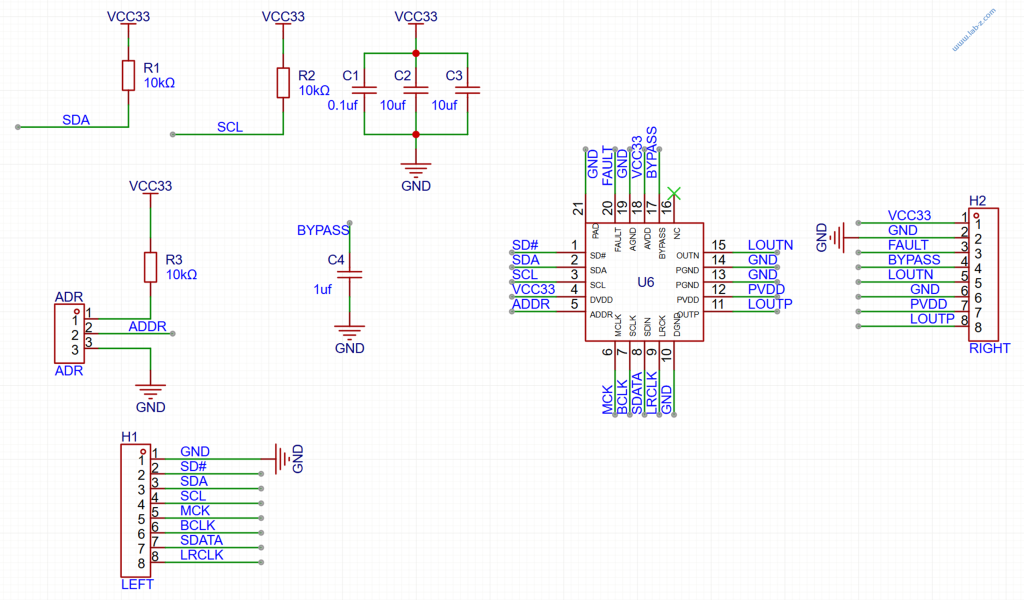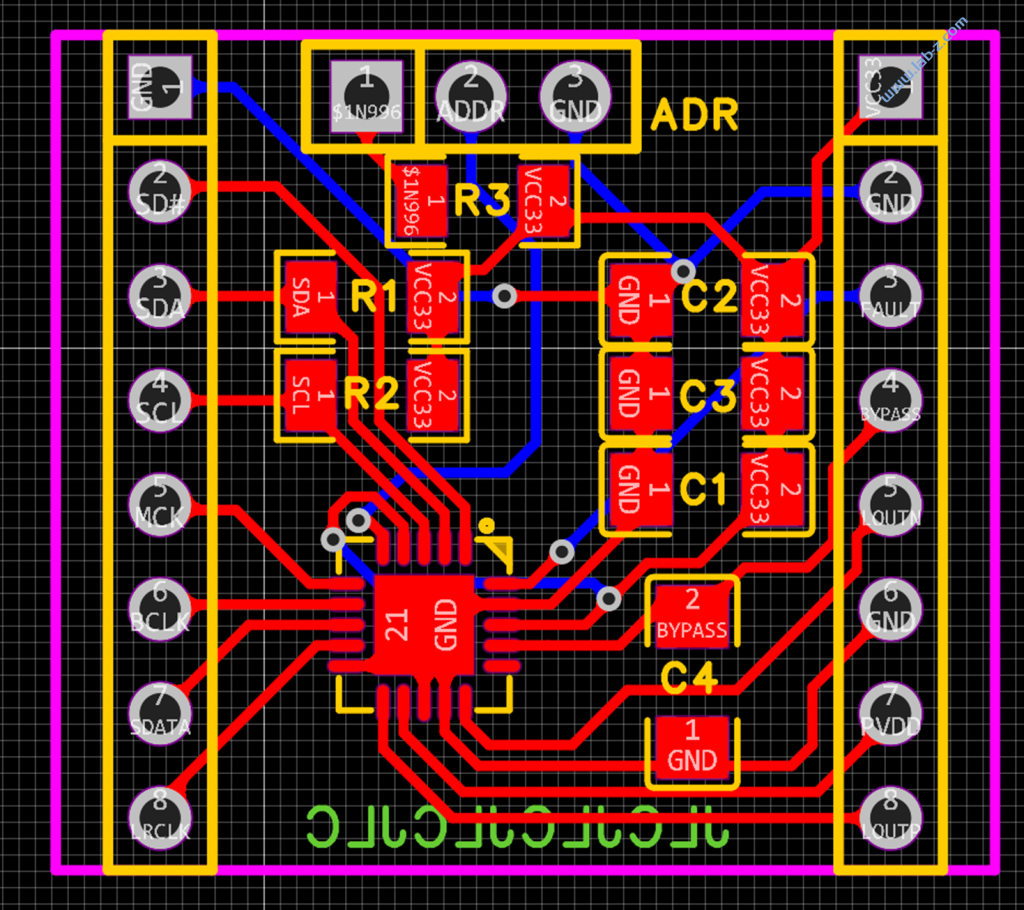HT513 是一款国产的D类单声道I2S 功放芯片。特别之处在于它支持通过 I2C 接口控制输出音量,因此可以在保证输出效果的情况下极大简化软件设计。
首先设计一个 HT513的功能板:

PCB设计如下:

焊接完成后,可以直接在面包板上使用。
这次测试DFRobot 的 FireBeetle 通过 I2S 接口发送音频数据给 HT513, 最终通过喇叭将音频播放出来:

| HT513模块 | FireBeetle | 说明 | 说明 | FireBeetle | HT513模块 | |
| GND | GND | 地 | 数字电源 | 3V3 | VCC33 | |
| SD# | N/A | 接地关闭功放 | 地 | GND | GND | |
| SDA | IO21 | I2C 数据 | 芯片错误 | N/A | FAULT | |
| SCL | IO22 | I2C 时钟 | 模拟参考电压 | N/A | BYPASS | |
| MCK | IO0 | I2S主时钟 | 功放负输出 | N/A | LOUTN 接喇叭 | |
| BCLK | 14 | I2S串行时钟 | 地 | GND | GND | |
| DIN | 18 | I2S数据 | 功率电源 | VCC | PVDD | |
| LRCLK | 15 | 帧时钟 | 功放正输出 | N/A | LOUTP 接喇叭 |
测试使用 AudioTools 库(arduino-audio-tools-1.0.0)。特别注意: HT513 工作时需要 MCLK 信号,因此需要修改库文件 AudioConfig.h:
#define PWM_FREQENCY 30000
#define PIN_PWM_START 12
#define PIN_I2S_BCK 14
#define PIN_I2S_WS 15
#define PIN_I2S_DATA_IN 32
#define PIN_I2S_DATA_OUT 18
#define PIN_I2S_MCK 0
#define I2S_USE_APLL true
// Default Setting: The mute pin can be switched actovated by setting it to a gpio (e.g 23). Or you could drive the LED by assigning LED_BUILTIN
#define PIN_I2S_MUTE -1
#define SOFT_MUTE_VALUE 0
#define PIN_CS SS
#define PIN_ADC1 34
测试的代码是基于这个库自带的两个例程,一个是生成正弦波送至I2S接口(streams-generator-i2s),我们在这里测试评估 HT513音量调整的功能;另外一个是播放存储在 Flash 中的WAV文件(streams-memory_raw-i2)。在例子的寄存上增加对于 HT513初始化设定的代码。关键部分如下:
#define HT513_ADDR_L 0x6c
/**
@brief ht513写寄存器
@param addr 寄存器地址
@param val 要写的值
@retval None
*/
void HT513_WriteOneByte(uint8_t addr, uint8_t val)
{
Wire.beginTransmission(HT513_ADDR_L);
Wire.write(addr);
Wire.write(val);
Wire.endTransmission(true);
}
/**
@brief ht513读寄存器
@param addr 寄存器地址
@retval 读取到的寄存器值
*/
uint8_t HT513_ReadOneByte(uint8_t addr)
{
uint8_t temp = 0;
Wire.beginTransmission(HT513_ADDR_L);
Wire.write(addr);
Wire.endTransmission(true);
Wire.requestFrom(HT513_ADDR_L, (uint8_t)1);
temp = Wire.read();
return temp;
}
在Setup() 中加入下面的代码:
Wire.begin(21,22);
// 设置 SD 为LOW
HT513_WriteOneByte(0x12,0b11110000);
// 设置数据格式为 I2S, 16Bits
HT513_WriteOneByte(0x13, 0b00110000);
// 调整音量
HT513_WriteOneByte(0x16, 0b10100000);
// 设置 SD 为LOW
HT513_WriteOneByte(0x12,0b11110100);
其中的HT513_WriteOneByte(0x16, XX) 是调整音量的代码:

换句话说,有了上面的代码就可以完整的发挥出 HT513的功能了。
最终完整的代码streams-generator-i2sHT513.ino 如下:
#include <Wire.h>
#include "AudioTools.h"
AudioInfo info(44100, 1, 16);
SineWaveGenerator<int16_t> sineWave(32000); // subclass of SoundGenerator with max amplitude of 32000
GeneratedSoundStream<int16_t> sound(sineWave); // Stream generated from sine wave
I2SStream out;
StreamCopy copier(out, sound); // copies sound into i2s
#define HT513_ADDR_L 0x6c
/**
@brief ht513写寄存器
@param addr 寄存器地址
@param val 要写的值
@retval None
*/
void HT513_WriteOneByte(uint8_t addr, uint8_t val)
{
Wire.beginTransmission(HT513_ADDR_L);
Wire.write(addr);
Wire.write(val);
int ack = Wire.endTransmission(true);
Serial.print("Ack ");
Serial.println(ack, HEX);
}
/**
@brief ht513读寄存器
@param addr 寄存器地址
@retval 读取到的寄存器值
*/
uint8_t HT513_ReadOneByte(uint8_t addr)
{
uint8_t temp = 0;
Wire.beginTransmission(HT513_ADDR_L);
Wire.write(addr);
Wire.endTransmission(false);
uint8_t bytesReceived = 0;
bytesReceived = Wire.requestFrom(HT513_ADDR_L, (uint8_t)1, true);
if (bytesReceived == 1) {
temp = Wire.read();
}
else {
Serial.println("Read Error ");
}
return temp;
}
// Arduino Setup
void setup(void) {
Wire.begin(21,22);
// Open Serial
Serial.begin(115200);
while (!Serial);
AudioLogger::instance().begin(Serial, AudioLogger::Info);
// start I2S
Serial.println("starting I2S...");
auto config = out.defaultConfig(TX_MODE);
config.copyFrom(info);
out.begin(config);
// Setup sine wave
sineWave.begin(info, N_B4);
Serial.println("started...");
int nDevices;
byte error, address;
Serial.println("Scanning...");
nDevices = 0;
for( address = 1; address < 127; address++ ) {
Wire.beginTransmission(address);
error = Wire.endTransmission();
if (error == 0) {
Serial.print("I2C device found at address 0x");
if (address<16) {
Serial.print("0");
}
Serial.println(address,HEX);
nDevices++;
}
else if (error==4) {
Serial.print("Unknow error at address 0x");
if (address<16) {
Serial.print("0");
}
Serial.println(address,HEX);
}
}
if (nDevices == 0) {
Serial.println("No I2C devices found\n");
}
else {
Serial.println("done\n");
}
// 设置 SD 为LOW
HT513_WriteOneByte(0x12, 0b11110000);
// 设置数据格式为 I2S, 16Bits
HT513_WriteOneByte(0x13, 0b00110000);
// 调整音量
HT513_WriteOneByte(0x16, 0b01111111);
// 设置 SD 为HIGH
HT513_WriteOneByte(0x12, 0b11110100);
uint8_t Value = HT513_ReadOneByte(0x12);
Serial.println("++++++++++++++++");
Serial.println(Value, HEX);
}
// Arduino loop - copy sound to out
void loop() {
copier.copy();
}
本文提到的HT513 测试板电路图和 PCB:
工作的视频在:
===============================================
2025年6月8日 重新测试遇到一些问题
1.新版本的AudioTools 似乎对于 44.1K 的采样率支持有一些问题,建议降低频率进行实验;
2.上述代码推荐修改为 AudioInfo info(16000, 2, 16); 再进一步实验。
3.如果没有声音,首先示波器确认所有的I2S信号,然后检查输出的格式,如果是 32Bit 那么需要检查是否是输入数据太小导致的,比如:SineWaveGenerator sineWave(32000);此外,还要确认ESP32输出的数据是否只有一个声道,对应的 HT513 是否打开了这个声道(0x17 ch_Shift)